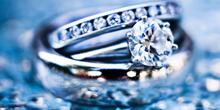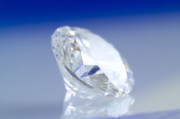
HOW TO FIND US
Robinson Jewelers
103 E. Butler Road
Mauldin, SC 29662
BUSINESS HOURS
Monday - Friday 10:00am - 5:00pm
Email: robinsonjewels@aol.com
Or fill out our contact form

UNDERSTANDING THE 4 C’s
THE 4 C’s OF DIAMOND QUALITY
Diamonds are among the most beloved of all gems. The value of a diamond will differ greatly. Diamonds are evaluate for rarity and beauty, using four primary guidelines. These are called The Four C's—Cut, Color, Clarity, and Carat Weight. The 4 C's are the criteria jewelers use when grading diamonds.
Cut
When you think of the cut of a
diamond, the majority of people think of the shape of the diamond. The cut does refer to the shape, but it also refers to the porportions of how the diamond is cut. The overall porportions of a
diamond, as well as the placement and size of its facets, also plays a large part in the cut of the diamond. Consistency and balance of these will greatly affect how the diamond captures light and
reflects it back to the eye. . The cut refers to tiny facets, 58 to be exact, carefully cut into each
diamond.
The cut of the diamond has three
attributes: Brillance, Fire, and Scintillation
-
Brillance - is the total light reflected from a diamond
-
Fire - dispersion of light into the colors of the spectrum
-
Scintillation - the sparkle of the diamond when it is moved
Diamonds are cut into many different shapes. The most popular shapes include round, princess, cushion, radiant, assher, oval, emerald and baguette cuts. Many specialty shapes are also available.
Color
With the exception of some fancy colored diamonds, the most valuable diamonds are those with the least color.The color of diamonds actually refers to how "colorless" they can be. The less color--or yellow tint in the diamond, the more valuable it is. The color scale for transparent diamonds runs from D-F (colorless), G-J (near colorless), K-L (faint yellow), to Z (light yellow). Completely colorless diamonds are rare.
When diamonds are formed with traces of other minerals, rare and beautiful colors can result. These "fancy" colors range from blue to brilliant yellow to red, brown, pale green, pink, and violet. Because of their rarity, colored diamonds are highly desirable and may be quite valuable.
|
GIA color grade |
Description |
Appearance |
|
D |
Colorless |
Stone looks absolutely clear, with no hint of color to the eye in color grading or mounted |
|
E |
||
|
F |
||
|
G |
Near Colorless |
Some color tint is visible during grading. Mounted in a setting, stone appears colorless. GHI color diamonds are considered very nice diamonds for fine jewelry. |
|
H |
||
|
I |
||
|
J |
||
|
K |
Faint yellow |
Yellow or grayish tint is obvious during color grading. Mounted, this stone still shows a tint of color |
|
L |
||
|
M |
||
|
N-Z |
Light yellow |
Obvious yellow or grayish color |
|
Z+ |
Fancy |
Bright, remarkable color - usually blue, pink, yellow |
Clarity
The clarity of the diamond refers to how flawless the diamond is when viewed through 10 x magnification. A diamond's clarity is measured by the existence, or absence, of visible flaws. Flawless diamonds are worth alot more money because they are more rare. Even diamonds with slight imperfections can still be costly.
Tiny surface blemishes or internal inclusions -- even those seen only under magnification with a jeweler's loupe can alter the brilliance of the diamond and this will effect its value. Clarity levels begin with Flawless (F & IF) and move down to Very Very Slight (VVS1 & 2), Very Slight (VS1 & 2), Slightly Included (SI1 & 2), and Included (I1, 2 & 3).
- Flawless (FL)
No inclusions and no blemishes visible under 10x magnification - Internally Flawless (IF)
No inclusions visible under 10x magnification - Very, Very Slightly Included (VVS1 and
VVS2)
Inclusions so slight they are difficult for a skilled grader to see under 10x magnification - Very Slightly Included (VS1 and
VS2)
Inclusions are observed with effort under 10x magnification, but can be characterized as minor - Slightly Included (SI1 and
SI2)
Inclusions are noticeable under 10x magnification - Included (I1, I2, and
I3)
Inclusions are obvious under 10x magnification which may affect transparency and brilliance
Carat Weight
The size of a diamond is measured by weight. One carat, the traditional unit of measure for diamonds, is equal to approximately 0.2 grams. The weight of a diamond is also referred to in points. A point is equal to 1/100 of a carat; therefore, a 50-point diamond equals 0.50 carat. Diamonds of equal weight can appear slightly different in size, depending on their depth and proportions. Because they are quite rare, larger diamonds of gem quality are much more valuable.
Now that we have given you some information on the 4C's,
come in and let us help you select your special diamond.
r American Gem Society Consumer Protection Since 1934

